Unit Testing: Final testing code
-
[TestCase(0, 1)] [TestCase(1, 1)] [TestCase(2, 2)] [TestCase(3, 6)] [TestCase(15, 1307674368000)] public void TryGetFactorial_WhenNIsInBounds_ShouldReturnNthFactorial( int n, long expected ) => Assert.That(expected, Is.EqualTo(TestExerciseLib.TryGetFactorial(n)));[TestCase(-1)] [TestCase(151)] public void TryGetFactorial_NIsOutOfBounds_ShouldThrowArgumentOutOfRange( int n ) => Assert.Throws<ArgumentOutOfRangeException>( () => TestExerciseLib.TryGetFactorial(n) );
Writing testable code
- Writing testable code often means that you're writing good code
- Testable units should
- be deterministic (functional): same input always produces the same output
- be loosely coupled: components have a loose and limited connection to other components in the system, meaning changes in one component should not require changes to many others
- abide to the Single Responsibility Principle: a function, method or component is only responsible for one purpose
Writing testable code: Example 1
- Can
GetCurrentSeason()be unit tested? Why / why not? - How to fix the problems, if any?
public static class Season
{
public static string GetCurrentSeason() {
DateTime currentTime = DateTime.Now;
if (currentTime.Month > 11 && currentTime.Month < 3)
return "Winter";
else if (currentTime.Month < 6)
return "Spring";
else if (currentTime.Month < 9)
return "Summer";
else
return "Fall";
}
}
Writing testable code: Example 1 fixed
- Now the method is purely functional and deterministic
- Will return the same value for every call with equal arguments
GetCurrentSeason()can now easily be tested as shown next
public static class Season {
public static string GetCurrentSeason(
DateTime currentTime
) {
if (currentTime.Month > 11 && currentTime.Month < 3)
return "Winter";
else if (currentTime.Month < 6)
return "Spring";
else if (currentTime.Month < 9)
return "Summer";
else
return "Fall";
}
}
public class GetCurrentSeasonTest
{
[TestCase(12, "Winter")]
[TestCase(3, "Spring")]
[TestCase(6, "Summer")]
[TestCase(9, "Fall")]
public void GetCurrentSeason_ForFirstMonthsOfSeasons_ReturnsCorrectSeason(
int month,
string season
)
{
Assert.That(season,
Is.EqualTo(
Season.GetCurrentSeason(new DateTime(2020, month, 1))
)
);
}
}
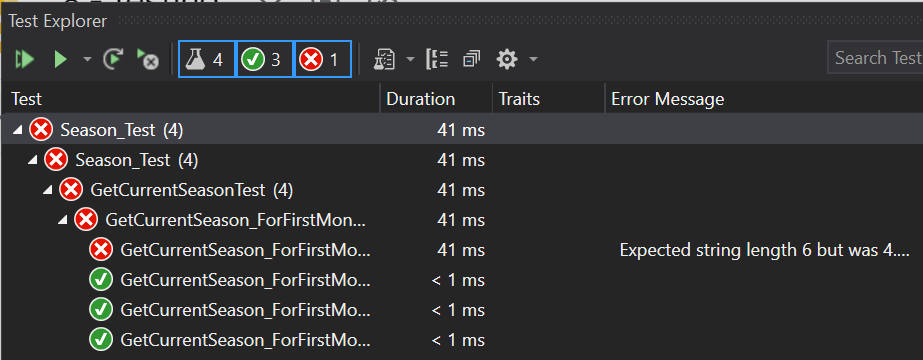
- The tests fail, as shown above.
- Test results indicate there is something wrong with the code path that should return
Winterif (currentTime.Month > 11 && currentTime.Month < 3) - The line should be changed to
if (currentTime.Month > 11 || currentTime.Month < 3)
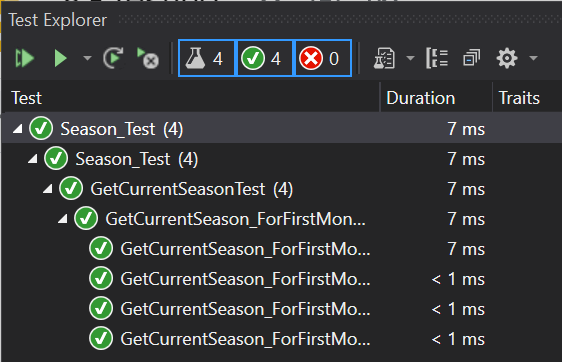
Writing testable code: Example 2
- Let's look at a
HeatingUnitclass that returns a heating setting based on the current season. The current date problem is back again:public class HeatingUnit { public string GetHeatingSetting() { DateTime currentDate = DateTime.Now; if (Season.GetCurrentSeason(currentDate) == "Winter") return "HEAT_SETTING_HIGH"; else if (Season.GetCurrentSeason(currentDate) == "Summer") return "HEAT_SETTING_OFF"; else return "HEAT_SETTING_MEDIUM"; } }
Writing testable code: Example 2 continued
- Instead of taking the current date initialization even higher in the class hierarchy, let's make a service that returns the current date
public interface IDateTimeProvider { DateTime GetDateTime(); } - After this the service can be injected into
HeatingUnitwith constructor injection - Code example shown next
public class HeatingUnit
{
private readonly IDateTimeProvider _dateTimeProvider;
public HeatingUnit(IDateTimeProvider dateTimeProvider)
{
_dateTimeProvider = dateTimeProvider;
}
public string GetHeatingSetting() {
if (Season.GetCurrentSeason(_dateTimeProvider.GetDateTime()) == "Winter")
return "HEAT_SETTING_HIGH";
else if (Season.GetCurrentSeason(_dateTimeProvider.GetDateTime()) == "Summer")
return "HEAT_SETTING_OFF";
else
return "HEAT_SETTING_MEDIUM";
}
}
-
For testing, a fake
DateTimeProviderservice can be used for injecting theHeatingUnitwith any date:class FakeDateTimeProvider : IDateTimeProvider { public DateTime Date { get; set; } public DateTime GetDateTime() => Date; } -
Using this kind of a fake service instead of the real one is called mocking
-
In the real application the provider would return the real current date
class SetHeatingSettingTest
{
[TestCase(12, "HEAT_SETTING_HIGH")]
[TestCase(3, "HEAT_SETTING_MEDIUM")]
[TestCase(6, "HEAT_SETTING_OFF")]
[TestCase(9, "HEAT_SETTING_MEDIUM")]
public void SetHeatingSetting_ForFirstMonthsOfSeasons_ShouldReturnCorrectSetting(
int month,
string setting
)
{
FakeDateTimeProvider timeProvider
= new FakeDateTimeProvider { Date = new DateTime(2020, month, 1) };
HeatingUnit heatingUnit = new HeatingUnit(timeProvider);
Assert.That(setting, Is.EqualTo(heatingUnit.GetHeatingSetting()));
}
}
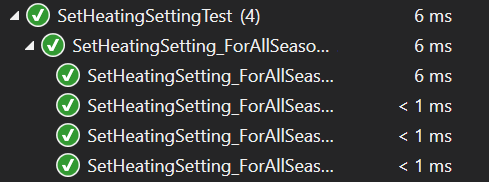
Tests should pass!
Testing with Postman
- So far, we have created individual request with Postman to see what the response of an API is for each request
- This is not testing an API, this is exploring an API
- Tests in Postman are inserted in the Tests tab
- Postman uses the Chai.js testing library for creating tests

- Postman uses the Chai.js testing library for creating tests
- To get started immediately, you can select snippets from the right
- Let's select the Status code: Code is 200 snippet

- Successfully run tests show up in green in the Test Result tab of the response:
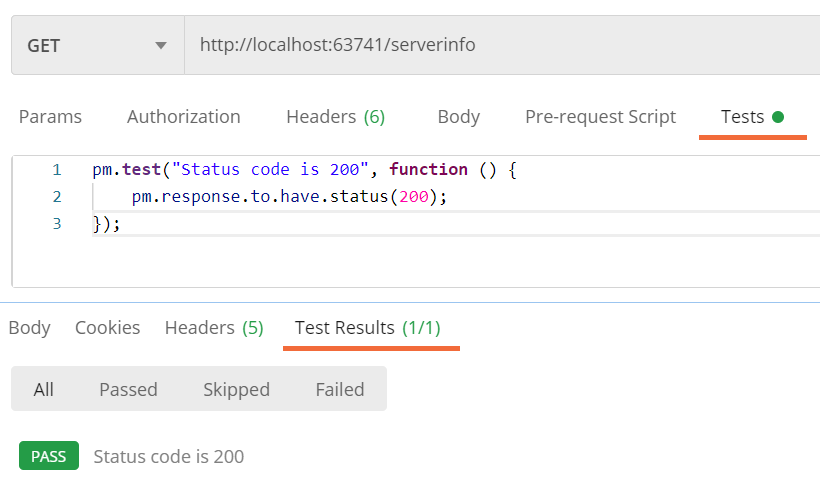
- The official Postman web page is a good starting point for learning testing with Postman
- Using
pm.expectwill give a bit more info about the test:
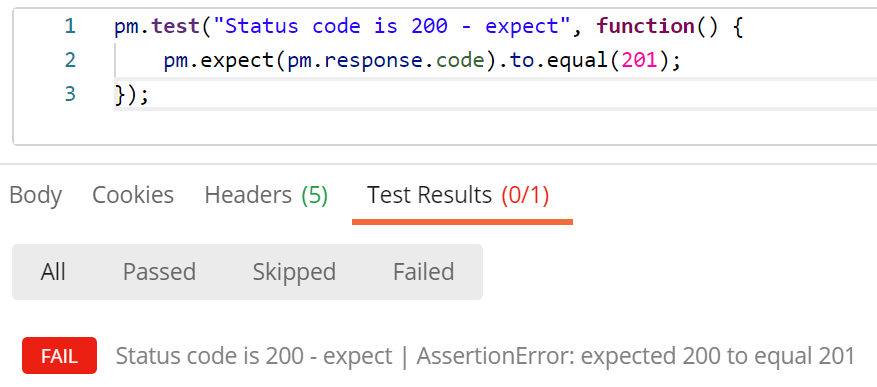
- The response to /serverinfo has the following body:
{ "appSettings": { "applicationUrl": "http://localhost:63741", "aspNetCoreEnvironment": "Development" }, "serverStatus": { "dbConnectionStatus": "Connected" } } - Let's make a test to see whether the server is connected to the database
- Variables can be declared within the test:
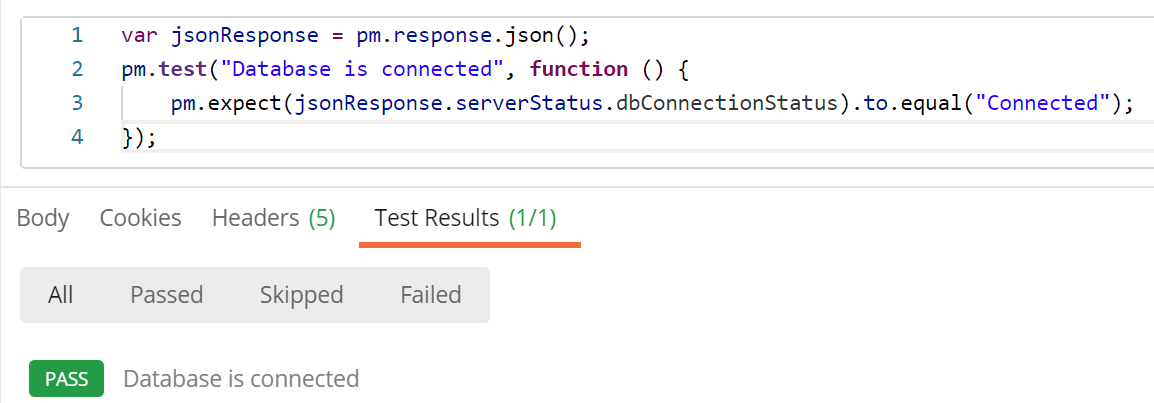
Exercise 3: Testing with Postman
- Create a new collection in Postman by selecting the Collections tab and clicking New Collection. Name it
CourseAPI Tests. Launch the CourseAPI you have developed during the lectures, and make sure thecourse_dbdatabase is connected - Create a new
GETrequest for the URI/api/courses. Add a test: status code of the request should be 200. Save the request to theCourseAPI Testscollection. - Create a new
GETrequest for the URI/api/courses/999999999. Add a test: status code of the request should be 404. Save the request to theCourseAPI Testscollection.
- Create a new
POSTrequest for the URI/api/courses. Set the headers and the content correctly, but set the value of credits to 100. Add a test; status code should be 400. Save the request to the CourseAPI Tests collection. - Hover on CourseAPI Tests collection, click the arrow and click Run. From the opened window, scroll down and click Run CourseAPI Tests. This will create all the requests in your collection.
CI/CD/CT
- CI stands for Continuous Integration
- Each change in code triggers a build-and-test sequence for the given project
- Goal is to have a consistent and automated way to build, package, and test applications
- CD stands for Continuous Delivery
- Automates the delivery of applications to selected environments, such as Azure, AWS, GCP
- Both require Continuous Testing, which includes automated regression, performance and other tests